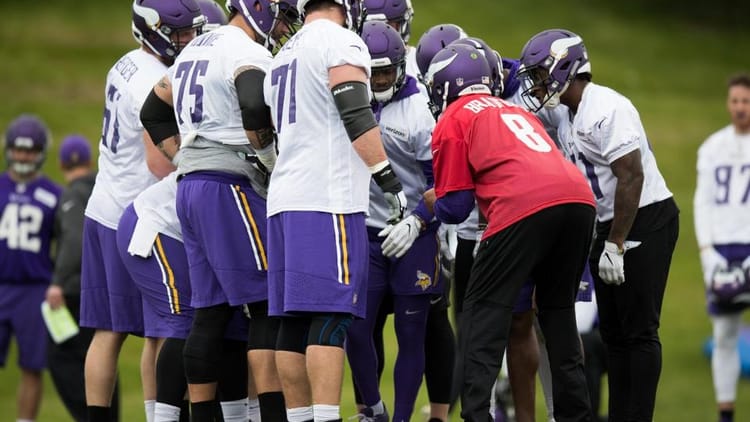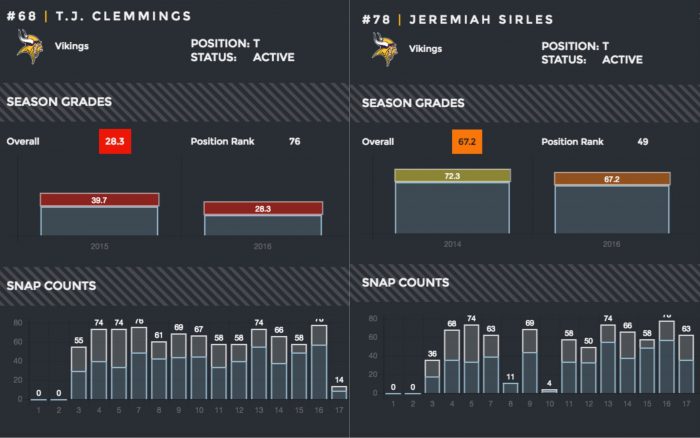GUEST POST: What Have The Vikings Done To Fix Their Offense?

This post was guest-written by Luke Braun, who is a writer for Purple PTSD and co-host of the Purple Journal Podcast. Since before he can remember, he was immersed in the ups and crippling downs of Vikings fandom. In adulthood, he’s taken an analytical approach to evaluation, but the compelling stories of each NFL player are not lost on him. Outside of football, Luke works in digital media and the film industry, giving him a unique perspective on the characters and story of the NFL.
It’s fairly clear that the 2016 Minnesota Vikings were held back by their offense more than their defense or special teams. By DVOA, the Vikings ranked 26th on offense, while turning in the ninth-best defense. They experienced a post-bye streak of seven games where they only topped 21 points once, losing all six of the other games.
In response to the general failure of the offense, Mike Zimmer set the bar at 21 points per game for 2017, establishing a clear goal to improve. The first step to fixing a problem, however, is diagnosing it. Where did we go wrong?
It’s easy to point to the offensive line and call it a day. T.J. Clemmings and Jeremiah Sirles got the lion’s share of the snaps at both tackle positions, and both were atrocious. Pro Football Focus (PFF) does an excellent job of visualizing not only their poor quality but how often the team had to lean on that quality:

It’d be naive to leave this out, though it’s not exactly a new revelation. We all know that Sirles and Clemmings were primarily responsible for the team’s derailment (and to a degree, the injuries that put them there). But it takes more than a couple tackles to turn a Super Bowl contender into an 8-8 catastrophe.
The run game is a natural next step. With the offensive line woes and the lackluster pairing of Jerick McKinnon and Matt Asiata, the Vikings were dead last in total rushing. But how much does total rushing matter?
Rush yards only accounted for 31% of the total NFL production in 2016. FiveThirtyEight even argues that it’s best to phase out the run game altogether. Matthew Coller, on the other hand, argues the Vikings could have made the playoffs with only an average running game, rather than an abysmal one.
But a look at the specifics reveals a much more telling, and more useful truth. Down and distance roadmap in such evaluations. For example, a two-yard run could be a great play in a situation where the Vikings faced 3rd & 1.
On 1st & 10, runs have a different value. In those instances, the Vikings only gained 3.09 yards per rushing attempt, which was 31st in the league, per Pro Football Reference. By contrast, they ranked 11th in first down passing, with an average play gaining 7.12 yards.
One way to judge play “success” is using Football Outsiders’ definition of success rate; success would entail gaining 40% of the yards to go on first down, 60% on second down, and 100% on third and fourth down. Essentially, it measures whether or not you made the next down manageable. For the Vikings, only 37% of their first down runs gained four or more yards. That ranked 29th in the league.
Thus, the Vikings’ average third-down distance was 7.4 yards in 2016, which was 11th in the league. Put differently, the Vikings faced, on average, the 11th-hardest third downs of all teams last season. Couple that with a general tendency to throw short of the sticks, and you have a brewing disaster.
How do you fix the Vikings’ offense?
At this point, we’ve reached a fork in the road. Either we adjust our philosophy to accommodate for this problem, throwing deeper on third down and taking more risks, or try to make third downs easier with shorter passes early.
Should you choose the more aggressive option, you reach a conundrum. Defensive linemen are ready to tee off on third-and-long, employing aggressive techniques—blitzes, Cover 0—that risk giving up big run plays. They can comfortably do this because, in typical third-and-long situations, they’ll rarely face a run play.
To adjust, an offensive coordinator will likely include more blockers, maybe a running back or tight end, or both. The problem, however, is that each additional blocker results in one less route. So, if a team can get pressure with four rushers (something they could do with consistency thanks to the futility mentioned above), they can leave seven in coverage, putting the quarterback in a disadvantageous position. Sam Bradford checks down instead of forcing an interceptable throw, everyone laments their idea of conservative tendencies, and we bring out the punting unit.
With Pat Shurmur, a well-known West Coast advocate, it’s clear which way the Vikings want to go. Instead of trying to become better on third and long, they’ll aim to face fewer of these situations. A short crosser is a viable option if you can get it to third-and-five rather than third-and-nine.
The Vikings’ allocation of resources has been very clearly directed at improving the run, not the pass. If we call the acquisition of Mike Remmers and Riley Reiff moves that are equally dedicated to the run and pass, the rest of the Vikings’ offensive additions show a clear favorite.
| Player | Run | Pass |
|---|---|---|
| Latavius Murray | $15,000,000 | |
| Michael Floyd | $1,500,000 | |
| Case Keenum | $2,000,000 | |
| Dalvin Cook | Pick 41 | |
| Pat Elflein | Pick 70 | |
| Rodney Adams | Pick 170 | |
| Danny Isidora | Pick 180 | |
| Bucky Hodges | Pick 201 | |
| Stacy Coley | Pick 219 | |
| Total | $15M, 2nd, 3rd, 5th | $3.5M, 5th, 6th, 7th |
The differences are stark. Considering that the passing game hovered between 12th and 18th in most categories, while the run game struggled to escape the bottom three, this shouldn’t be a hard choice.
But breaking down the causes for the Vikings’ offensive struggles shows a roadmap, and it’s one Rick Spielman and company have aggressively pursued. Any potential narratives of neglect will be rooted in hindsight, not fact.
Thanks for reading! If you’d like to see more of Luke’s work (and plenty of other great content), be sure to visit Purple PTSD today!

You must be logged in to post a comment.